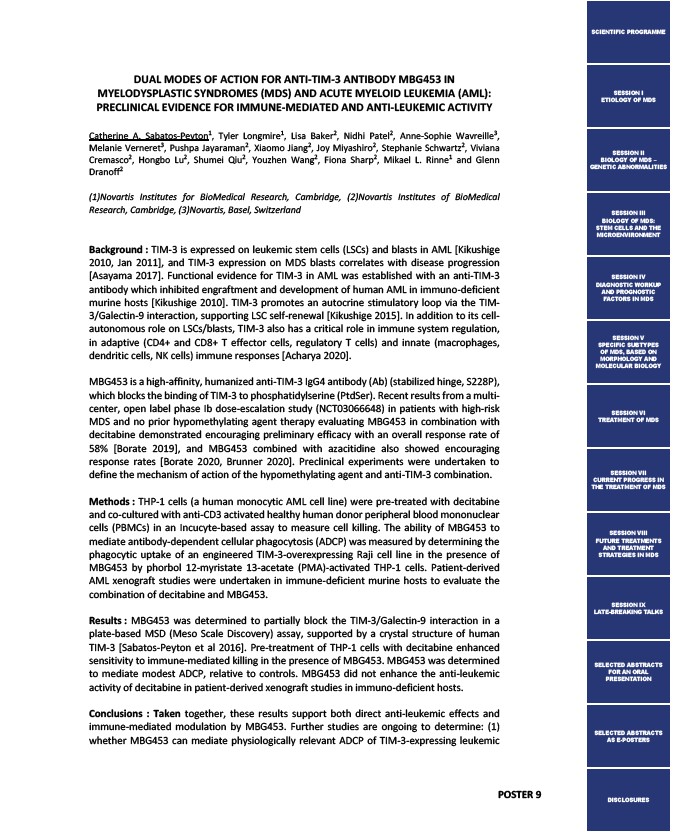
DUAL MODES OF ACTION FOR ANTI-TIM-3 ANTIBODY MBG453 IN
MYELODYSPLASTIC SYNDROMES (MDS) AND ACUTE MYELOID LEUKEMIA (AML):
PRECLINICAL EVIDENCE FOR IMMUNE-MEDIATED AND ANTI-LEUKEMIC ACTIVITY
Catherine A. Sabatos-Peyton1, Tyler Longmire1, Lisa Baker2, Nidhi Patel2, Anne-Sophie Wavreille3,
Melanie Verneret3, Pushpa Jayaraman2, Xiaomo Jiang2, Joy Miyashiro2, Stephanie Schwartz2, Viviana
Cremasco2, Hongbo Lu2, Shumei Qiu2, Youzhen Wang2, Fiona Sharp2, Mikael L. Rinne1 and Glenn
Dranoff2
(1)Novartis Institutes for BioMedical Research, Cambridge, (2)Novartis Institutes of BioMedical
Research, Cambridge, (3)Novartis, Basel, Switzerland
Background : TIM-3 is expressed on leukemic stem cells (LSCs) and blasts in AML Kikushige
2010, Jan 2011, and TIM-3 expression on MDS blasts correlates with disease progression
Asayama 2017. Functional evidence for TIM-3 in AML was established with an anti-TIM-3
antibody which inhibited engraftment and development of human AML in immuno-deficient
murine hosts Kikushige 2010. TIM-3 promotes an autocrine stimulatory loop via the TIM-
3/Galectin-9 interaction, supporting LSC self-renewal Kikushige 2015. In addition to its cell-autonomous
role on LSCs/blasts, TIM-3 also has a critical role in immune system regulation,
in adaptive (CD4+ and CD8+ T effector cells, regulatory T cells) and innate (macrophages,
dendritic cells, NK cells) immune responses Acharya 2020.
MBG453 is a high-affinity, humanized anti-TIM-3 IgG4 antibody (Ab) (stabilized hinge, S228P),
which blocks the binding of TIM-3 to phosphatidylserine (PtdSer). Recent results from a multi-center,
open label phase Ib dose-escalation study (NCT03066648) in patients with high-risk
MDS and no prior hypomethylating agent therapy evaluating MBG453 in combination with
decitabine demonstrated encouraging preliminary efficacy with an overall response rate of
58% Borate 2019, and MBG453 combined with azacitidine also showed encouraging
response rates Borate 2020, Brunner 2020. Preclinical experiments were undertaken to
define the mechanism of action of the hypomethylating agent and anti-TIM-3 combination.
Methods : THP-1 cells (a human monocytic AML cell line) were pre-treated with decitabine
and co-cultured with anti-CD3 activated healthy human donor peripheral blood mononuclear
cells (PBMCs) in an Incucyte-based assay to measure cell killing. The ability of MBG453 to
mediate antibody-dependent cellular phagocytosis (ADCP) was measured by determining the
phagocytic uptake of an engineered TIM-3-overexpressing Raji cell line in the presence of
MBG453 by phorbol 12-myristate 13-acetate (PMA)-activated THP-1 cells. Patient-derived
AML xenograft studies were undertaken in immune-deficient murine hosts to evaluate the
combination of decitabine and MBG453.
Results : MBG453 was determined to partially block the TIM-3/Galectin-9 interaction in a
plate-based MSD (Meso Scale Discovery) assay, supported by a crystal structure of human
TIM-3 Sabatos-Peyton et al 2016. Pre-treatment of THP-1 cells with decitabine enhanced
sensitivity to immune-mediated killing in the presence of MBG453. MBG453 was determined
to mediate modest ADCP, relative to controls. MBG453 did not enhance the anti-leukemic
activity of decitabine in patient-derived xenograft studies in immuno-deficient hosts.
Conclusions : Taken together, these results support both direct anti-leukemic effects and
immune-mediated modulation by MBG453. Further studies are ongoing to determine: (1)
whether MBG453 can mediate physiologically relevant ADCP of TIM-3-expressing leukemic
POSTER 9
SCIENTIFIC PROGRAMME
SESSION I
ETIOLOGY OF MDS
SESSION II
BIOLOGY OF MDS –
GENETIC ABNORMALITIES
SESSION III
BIOLOGY OF MDS:
STEM CELLS AND THE
MICROENVIRONMENT
SESSION IV
DIAGNOSTIC WORKUP
AND PROGNOSTIC
FACTORS IN MDS
SESSION V
SPECIFIC SUBTYPES
OF MDS, BASED ON
MORPHOLOGY AND
MOLECULAR BIOLOGY
SESSION VI
TREATMENT OF MDS
SESSION VII
CURRENT PROGRESS IN
THE TREATMENT OF MDS
SESSION VIII
FUTURE TREATMENTS
AND TREATMENT
STRATEGIES IN MDS
SESSION IX
LATE-BREAKING TALKS
SELECTED ABSTRACTS
FOR AN ORAL
PRESENTATION
SELECTED ABSTRACTS
AS E-POSTERS
DISCLOSURES